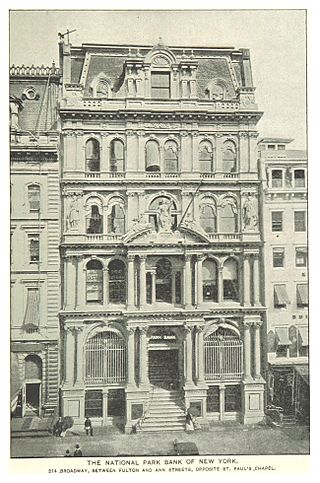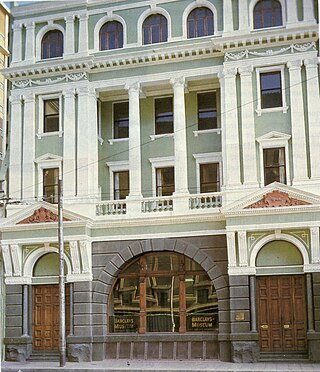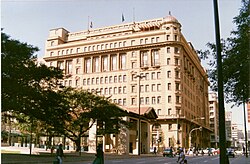
The National Park Bank was founded in 1856 in New York City, and by the late 19th century, it did more commercial business than any other bank in the country.

The Standard Bank Centre is a skyscraper in Johannesburg, South Africa. It is located at the corner of 5 Simmonds Street and 78 Fox Street in the Central Business District of the city. Construction of the building started in 1966 and was completed in 1968. It is 139 m (456 ft) tall. It was also home to Standard Bank, until the company moved to other site in 1990.

55 Wall Street, formerly known as the National City Bank Building, is an eight-story building on Wall Street between William and Hanover streets in the Financial District of Lower Manhattan in New York City, United States. The lowest three stories were completed in either 1841 or 1842 as the four-story Merchants' Exchange and designed by Isaiah Rogers in the Greek Revival style. Between 1907 and 1910, McKim, Mead & White removed the original fourth story and added five floors to create the present building. The facade and part of the interior are New York City designated landmarks, and the building is a National Historic Landmark listed on the National Register of Historic Places (NRHP). The building is also a contributing property to the Wall Street Historic District, listed on the NRHP.

The State Savings Bank Building is a heritage-listed large bank building and commercial offices situated at 48-50 Martin Place, in the Sydney central business district in the City of Sydney local government area of New South Wales, Australia. It was designed by Ross & Rowe Architects and Consulting Engineers and built from 1925 to 1928 by Concrete Constructions Ltd. It is also known as The Government Savings Bank of New South Wales, Commonwealth Bank building (former), and CBA Building. After several decades of use by the Commonwealth Bank of Australia, including as its headquarters from 1984, it was purchased by financial services company Macquarie Group in 2012, refurbished, and now serves as Macquarie's global headquarters as 50 Martin Place. It was added to the New South Wales State Heritage Register on 17 November 2000.

Valparaiso has retained an active downtown. It remains a mix of government, retail and business center, with a mixed residential and service area. Numerous economic changes have not changed the basic character, historic courthouse area. The historic district retains the distinctive turn-of-the-19th-century architecture, supporting numerous small specialty shops, shaded sidewalks, and a people friendly environment. The Downtown District, is anchored on the Porter County Courthouse. It includes 14-blocks surrounding the square, bounded on the north by Jefferson Street, on the east by Morgan Street, on the south by Monroe Street, and on the west by Napoleon Street.

The mansions of Parktown are an important part of the history of the city of Johannesburg. They were the homes of the Randlords, accountants, military personnel and other influential residents of early Johannesburg, dating back as early as the 1890s. The first of these mansions, Hohenheim was designed by Frank Emley and was built for Sir Lionel Phillips and his wife Lady Florence Phillips. The name Hohenheim had been used originally by Hermann Eckstein, one of the first Rand Lords to name his house after the place of his own birth. When Phillips became the head of Eckstein & Co, he moved in to Eckstein's house but due to the expansion of the city decided to build the new Hohenheim in an enviable site further from the mine workings. Sir Lionel Phillips was banished from the Republic for his involvement in the Jameson Raid. It is perhaps fitting that the next occupant of this famous house was none other than Sir Percy Fitzpatrick, the author of the best selling book 'Jock of the Bushveldt'. The house was demolished but a plaque remains in honor of this building.

The former Bank of Australasia Headquarters is an historic bank headquarters in Renaissance Revival style located on the corner of Queen Street and Collins Street, the traditional heart of Melbourne's financial precinct, with 19th Century banks on three corners.

The John Archibald Campbell United States Courthouse, also known as the United States Court House and Custom House, is a historic courthouse and former custom house in Mobile, Alabama. It was completed in 1935. An addition to the west was completed in 1940. It was added to the National Register of Historic Places on October 8, 2008.
Anstey's Building is an art deco building in the city of Johannesburg. The building took its name from the original owner of the building, Norman Anstey, founder of one of the best known department stores in the city. The Norman Anstey and Company department store was housed in the four-storey podium of the building, which features a curved facade to address the street corner.

The Standard Bank Building was designed by Architects Stucke & Bannister. It is found in Marshalltown in the city of Johannesburg in Commissioner, Harrison and Fox streets

The Consolidated Building, or ‘Johnnies’ as it became affectionately known, is an office building situated in the Marshalltown district of Johannesburg, on stands 149, 150 and 152 at 84/86 Fox Street and 29/31 Harrison Street. In 1895, before the Consolidated Building was built, these stands were home to the Jewish Social Club and in 1897, Johannesburg Waterworks had its offices there.

The Natal Bank Building is situated on Stand 194 at 90 Market Street in the city of Johannesburg. Natal Bank was the second bank to open a branch in the city after Standard Bank.

The Rand Club is a private members' club in Johannesburg, South Africa, founded in October 1887. The current (third) clubhouse was designed by architects Leck & Emley in 1902 and its construction completed in 1904. Cecil John Rhodes helped to select the location.

Manners Mansions was designed by the architectural firm of Emley and Williamson for African City Property Trust and was built in 1937-1939. The building is situated on stand 5198, at the corner of Jeppe and Joubert Streets in Johannesburg.

The Rand Water Board was established in 1903, tasked with supplying the water needed to support mining activities and sanitary living conditions for those living in the developing urban area of Johannesburg.
Lauriston Court is a residential building in Houghton Estate, Johannesburg. The building was designed by the prominent architecture firm, Emley and Williamson and completed in 1936.
Frank Emley was an English architect, who played an important part in designing several buildings in early Johannesburg in the practices of Leck and Emley and Emley and Williamson.

Reserve Bank of Australia Building is a heritage-listed bank building at 65 Martin Place, Sydney, New South Wales, Australia. It was added to the Australian Commonwealth Heritage List on 22 June 2004.

354 George Street, Sydney is a heritage-listed retail and office building and former bank building located at 354 George Street, in the Sydney central business district, in the City of Sydney local government area of New South Wales, Australia. It was designed in various stages by Edward Raht, A. K. Henderson, Joseland & Gilling and Kevin Winterbottom and Assoc. and built in various stages from 1902 to 1937 by Loveridge & Hudson and Kell & Rigby. It is also known as ANZ Bank (former); ANZ Bank; United Permanent Building; 2 Martin Place; Paspaley Pearls; 354-360 George Street; and Bank of Australasia. The property is owned by Paspaley Pearls Properties P/L. It was added to the New South Wales State Heritage Register on 2 April 1999.
Corner House in the central business district of Johannesburg was the headquarters of one of the largest mining conglomerates in South Africa. This building's unique history earned it a declaration as a national heritage monument in 1999.
















